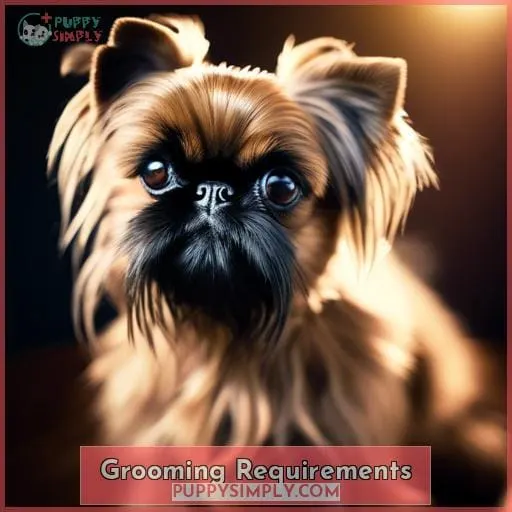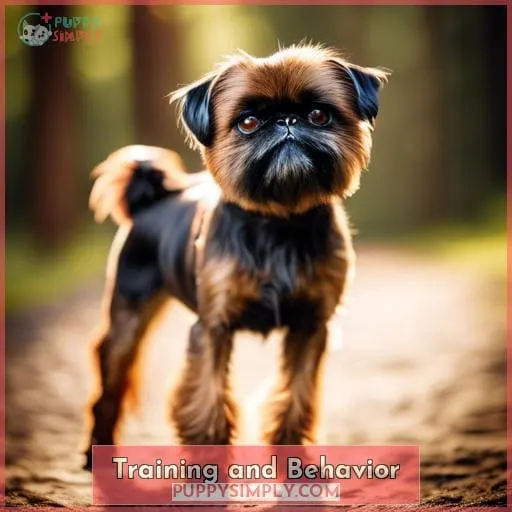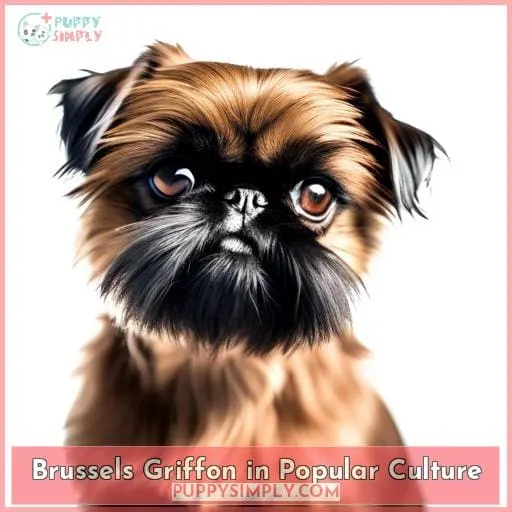This site is supported by our readers. We may earn a commission, at no cost to you, if you purchase through links.
 Prepare to fall in love with the Brussels griffon, a captivating canine companion that’s equal parts playful and stubborn.
Prepare to fall in love with the Brussels griffon, a captivating canine companion that’s equal parts playful and stubborn.
These charming dogs originated from Belgian street dogs, later gaining popularity among royalty.
With their distinctive brachycephalic features, varied coat types, and small size, Brussels griffons make unique and entertaining additions to any household.
Get ready to delve into the world of this delightful breed, discovering their temperament, health considerations, and the joys of living with a Brussels griffon.
Table Of Contents
- Key Takeaways
- Brussels Griffon Origins
- Physical Characteristics
- Temperament and Personality
- Health Considerations
- Grooming Requirements
- Exercise and Activity Needs
- Training and Behavior
- Diet and Nutrition
- Living With a Brussels Griffon
- Brussels Griffon in Popular Culture
- Frequently Asked Questions (FAQs)
- Are Brussels Griffons prone to separation anxiety and how can it be managed?
- How do Brussels Griffons typically react to changes in their environment, such as moving to a new home or introducing a new pet?
- What are some common behavioral challenges associated with Brussels Griffons, and how can they be addressed during puppyhood and adulthood?
- What are some recommended activities or sports that Brussels Griffons excel at, and how can owners encourage their participation in these activities?
- How can Brussels Griffons be effectively socialized with other dogs and animals, and what are some potential challenges that may arise during socialization?
- Conclusion
Key Takeaways
- Playful, energetic small companion breed with a mischievous streak and vermin-hunting ancestry
- Two coat varieties – rough or smooth; both shed moderately and require regular grooming
- Sensitive personality that craves companionship; intelligent but can be stubborn during training
- High exercise and play needs relative to their small size; climbing skills require supervision during play
Brussels Griffon Origins
The Brussels Griffon’s roots lie in the German Affenpinscher and Belgian street dogs.
They evolved in the 17th century and later gained popularity due to royal patronage.
German Affenpinscher Influence
Let’s begin with the German Affenpinscher’s contribution to the Brussels Griffon’s heritage.
Its influence is evident in the Griffon’s playful and energetic nature.
The Affenpinscher, meaning monkey-terrier in German, is known for its mischievous and lively personality.
This breed’s characteristics, combined with its crossbreeding history with Belgian street dogs, laid the foundation for the Brussels Griffon’s unique temperament and ancestral traits.
Belgian Street Dog Ancestry
You’ll also find traces of the Belgian street dog in the Brussels Griffon’s lineage.
These tenacious urban working dogs were prized for their rat-catching prowess and adaptability to city life.
Historically bred for their vermin-hunting skills, they also served as loyal companions and guardians, often riding in and guarding Belgian cabs.
Their unique heritage contributes to the Brussels Griffon’s distinctive character and enduring appeal as a toy breed.
17th Century Development
Your Brussels Griffon’s lineage can be traced to the 17th century when Belgian breeders mixed their street dogs with the German Affenpinscher.
This union birthed a new breed, prized for its vermin-hunting prowess and charming demeanor.
These early Griffons found favor among the Belgian populace, becoming ubiquitous sights riding in and guarding horse-drawn cabs.
As their popularity soared, breeders focused on refining the breed’s characteristics, laying the foundation for the Brussels Griffon we know today.
Royal Patronage and Popularity
During the 17th century, the Brussels Griffon’s popularity soared as it caught the eye of royalty, becoming a sought-after companion among the elite.
Aristocratic families across Europe embraced this charming breed, further solidifying its status as a symbol of nobility and wealth.
The Griffon’s playful and affectionate nature, coupled with its distinctive appearance, made it a favorite among monarchs and nobles, ensuring its place in history as a cherished companion to the powerful.
Physical Characteristics
The Brussels Griffon’s brachycephalic features, including a squashed face and prominent eyes, contribute to its distinctive appearance.
Coming in three coat varieties – rough, smooth, and a mix of the two – these small dogs typically weigh between 8 and 12 pounds, making them compact and easy to carry.
Brachycephalic Features
When you look at a Brussels Griffon, you’ll notice their distinctive brachycephalic features, characterized by a shortened muzzle and prominent eyes.
This unique facial structure can lead to certain health concerns, such as breathing difficulties and heat sensitivity, so ethical breeding practices are crucial.
Their dense coat, available in rough and smooth varieties, requires regular grooming to maintain its beauty and health.
Their erect ears and expressive eyes add to their charming appearance.
Coat Varieties
What coat options do you have with this breed?
Smooth or rough?
Both variations share a thick undercoat that keeps them warm and dry.
The smooth coat is short, glossy, and easy to maintain, requiring only occasional brushing.
The rough coat, on the other hand, is longer, wiry, and forms a distinct beard and mustache.
It demands regular brushing and occasional trimming to prevent matting.
Size and Weight
You’ll find Brussels Griffons reaching a height of 7 to 10 inches at the shoulder and weighing between 6 and 14 pounds.
While their compact size makes them great apartment dwellers, owners must prioritize weight management to prevent health issues common in brachycephalic breeds.
Their stocky build and even weight distribution contribute to their curious and playful nature, but potential owners should consider their lifestyle and ability to provide adequate exercise and training before bringing one of these lively companions home.
Temperament and Personality
You’ll find the Brussels Griffon to be a playful and energetic dog who thrives on companionship and interaction.
While intelligent and eager to please, they can also be stubborn, requiring patience and positive reinforcement during training.
Playful and Energetic Nature
As Brussels Griffons are playful and energetic dogs, they require lots of attention and interaction to thrive.
Witness their playful antics as they explore their surroundings, engaging in energetic playtime indoors.
Their love for playtime extends beyond mere physical activity; it’s a way for them to bond with their owners, receive mental stimulation, and socialize with new friends.
These charming, energetic companions will fill your days with laughter and affection.
Sensitivity and Companionship Needs
Gravitating toward your presence, Brussels Griffons crave companionship and abhor being alone.
Their sensitivity demands a patient hand and understanding heart, making early socialization and sensitivity training essential.
The table below further illustrates the importance of fulfilling their companionship needs:
| Companionship Benefits | Mental Health Support |
|---|---|
| Reduced stress | Improved mood |
| Increased happiness | Boosted self-esteem |
| Enhanced immunity | Reduced depression |
Intelligence and Stubbornness
Brussels Griffons are quite intelligent, but their stubbornness can make training challenging.
Patience is key when training these pups, as they can be quite opinionated.
However, their intelligence shines through in their problem-solving abilities and quick learning skills.
Positive reinforcement and a consistent approach are essential for successful training.
Keep them mentally stimulated with enrichment activities to prevent boredom and stubbornness from taking over.
Health Considerations
As a Brussels Griffon owner, you should be aware of certain health issues common to the breed:
- Eye problems like cataracts
- Orthopedic concerns such as hip dysplasia
- Breathing challenges due to their brachycephalic facial structure
Regular vet checkups are essential for early detection and management of these conditions.
Eye Issues
Eye health’s fragility in Brussels Griffons demands attentive care.
Preventative measures like routine vet checkups and lifestyle adjustments promoting vision care are crucial.
Early detection of ocular conditions enables prompt care, preserving sight.
A proper care regimen, including regular eye exams and treatment, is vital for maintaining visual wellness.
Monitoring progress ensures timely intervention and preservation of your furry gargoyle’s expressive eyes.
Orthopedic Concerns
Aside from potential eye issues, Brussels Griffons may also be prone to orthopedic concerns that you should be aware of.
Joint health is paramount for these active dogs, so exercise precautions are crucial.
Preventive care, like regular vet checkups and providing mobility aids if needed, can help your Griffon stand upright and keep moving.
Engage them in short, consistent indoor games to stimulate their minds and bodies while minimizing joint strain.
Brachycephalic Challenges
Brachycephaly’s challenges, common in Brussels Griffons, can lead to respiratory issues.
Breathing difficulties and heat sensitivity may arise due to their compressed airways.
Snoring concerns are prevalent, and airway management becomes crucial.
In severe cases, surgical options may be necessary to widen the nasal passages and improve airflow.
Grooming Requirements
As a Brussels Griffon owner, you’ll need to maintain your dog’s distinctive coat.
Whether it’s the wiry, rough variety or the sleek, smooth type, regular dental care and meticulous cleaning of skin folds are essential for keeping your pup healthy and comfortable.
Coat Care for Rough and Smooth Types
With two coat varieties, you’ll need to tailor your grooming routine for your Brussels Griffon’s unique fur.
Rough-coated Griffons require regular brushing to prevent mats and tangles.
Smooth-coated Griffons have a shorter, sleeker coat that needs less brushing, but they still benefit from regular grooming to remove dead hair and keep their coat shiny.
Both coat types shed moderately, so regular brushing will help control loose hair in your home.
Dental Hygiene
To maintain your Brussels Griffon’s oral health, diligent daily brushing can help prevent dental disease.
- Brush regularly: Dedicate a few minutes each day to brushing your Griffon’s teeth using a soft-bristled brush and toothpaste made specifically for dogs.
- Use dental chews: Offer your Griffon dental chews designed to clean teeth and freshen breath.
- Provide chew toys: Chewing on hard toys helps remove plaque and tartar buildup.
- Schedule professional cleanings: Take your Griffon for regular professional cleanings and checkups to maintain optimal oral health.
- Consider oral health products: Consult your vet about dental water additives or oral health products to enhance your Griffon’s dental hygiene routine.
Skin Fold Maintenance
Keep your Brussels Griffon’s nose and face folds clean and dry to prevent skin fold dermatitis and infection.
Regular cleaning is key:
- Use a soft cloth and warm water.
- Follow with thorough drying to avoid moisture buildup.
Consult your veterinarian for:
- Recommended cleaning solutions.
- A personalized routine.
Preventative Measures:
- Regular cleaning.
- Moisture management.
- Veterinarian guidance.
Treatment Options:
- Medicated wipes.
- Antifungal creams.
- Antibiotics, if necessary.
Exercise and Activity Needs
Brussels Griffons are active and playful dogs that need daily exercise to stay healthy and happy.
They’re agile climbers, so make sure to provide them with supervised playtime in a safe area.
Engage their minds with interactive toys and games to stimulate their intelligence.
Daily Exercise Importance
Your Brussels Griffon’s daily exercise is essential for their physical and mental well-being.
Regular activity keeps their bodies fit, minds sharp, and behavior in check.
Aim for at least 30 minutes of moderate exercise each day, divided into two or three sessions.
Engage them in activities like brisk walks, fetch, or interactive puzzle toys.
Supervise playtime to prevent injuries, especially when they’re climbing or jumping.
Keep them mentally stimulated with training, games, and socialization.
A well-exercised Griffon is a happy, healthy, and well-behaved companion.
Climbing Skills and Supervision
You’ll also need to supervise your Brussels Griffon’s climbing abilities and ensure they’re safe.
Their small size and agile nature make them adept climbers, but their penchant for scaling furniture and heights requires vigilance.
To ensure their vertical exploration is safe, provide supervised climbing opportunities, like cat trees or designated climbing structures.
| Safety Precaution | Climbing Opportunity | Heightened Awareness |
|---|---|---|
| Cat trees, designated climbing structures | Monitor playtime | |
| Window perches, elevated playtime | Secure windows | |
| Stable furniture, supervised climbing | Trim long nails |
Playtime and Mental Stimulation
Entertain your Brussels Griffon with a variety of interactive toys and games to stimulate their mind.
Engage them with toys that encourage:
- Chasing
- Chewing
- Problem-solving
Fetch games:
Engage their playful side with a game of fetch, using balls or toys they can easily carry.
Puzzle challenges:
Provide puzzle toys that require them to work for treats, stimulating their problem-solving abilities.
Interactive play:
Engage in interactive play sessions, such as hide-and-seek or tug-of-war, to strengthen your bond.
Training and Behavior
To train your Brussels Griffon:
- Start with crate training and housebreaking as puppies.
- Address barking and chewing issues early on with consistent commands and positive reinforcement.
- Socialize your Griffon with people and other animals.
- Enroll in obedience classes to teach basic commands and good manners.
Crate Training and Housebreaking
Crate training your Brussels Griffon puppy can provide a safe space and help with housebreaking.
It offers several benefits:
- A den-like retreat
- A place of comfort during travel
- A tool for housetraining
Begin crate training early, introducing your puppy to the crate gradually and positively.
Housebreaking success hinges on consistency and positive reinforcement.
- Establish a regular potty schedule
- Take your puppy out frequently
- Reward them for using the designated potty spot
Patience and consistency are key to a well-behaved Brussels Griffon.
Addressing Barking and Chewing
Addressing excessive barking and chewing in your Brussels Griffon requires patience, consistency, and positive reinforcement techniques.
Start training early, using clickers and treats to reward good behavior.
Discourage barking by providing interactive toys and environmental enrichment.
Behavioral modification involves teaching your Griffon acceptable outlets for chewing, like chew toys and bones.
Seek professional help if problems persist.
Socialization and Obedience
You’ll want to socialize your Brussels Griffon early on to help them learn how to behave appropriately around people and other animals.
Enroll them in puppy classes or socialization events to introduce them to new experiences and teach them basic obedience commands.
Proper training can curb their stubbornness, address barking and chewing issues, and prepare them for dog sports like agility or obedience trials.
With consistent training and positive reinforcement, your Brussels Griffon will become a well-behaved and obedient companion.
Diet and Nutrition
To keep your Brussels Griffon healthy and happy:
- Choose AAFCO-approved food that meets their nutritional requirements.
- Feed them 2-3 times a day in portions appropriate for their age and weight.
- Monitor their caloric intake to maintain a healthy weight.
AAFCO-Approved Food Selection
When choosing a diet for your Brussels Griffon, start by selecting AAFCO-approved food that fulfills their nutritional requirements.
These foods undergo rigorous testing to ensure they meet the standards set by the Association of American Feed Control Officials.
Homemade diets, while tempting, can be risky if not formulated correctly.
Stick to AAFCO-approved brands and consult your vet for personalized recommendations.
AAFCO Seal of Approval:
Look for the AAFCO seal on pet food labels to ensure it meets nutritional standards.
Nutritional Balance:
AAFCO-approved foods provide a balanced blend of proteins, fats, carbohydrates, vitamins, and minerals.
Life Stage Considerations:
Choose food specifically designed for your Griffon’s age and activity level.
Consult Your Vet:
Your veterinarian can help you select the best food for your dog’s individual needs.
Feeding Frequency and Portions
Choosing the right feeding schedule and portion sizes will help maintain your Brussels Griffon’s health and weight.
Aim for two to three meals daily, adjusting portions based on age, weight, and activity level.
Avoid overfeeding to prevent obesity, which can strain their joints and lead to other health issues.
Select a bowl that’s easy for your Griffon to eat from, and consider different types to minimize food allergies or dental problems.
Weight Management
To maintain your Brussels Griffon’s healthy weight:
- Monitor their calorie intake and adjust their diet accordingly.
- Obesity can lead to joint problems, heart disease, and other health issues.
Feed them a high-quality diet:
- Rich in lean protein
- Low in fillers
Avoid food allergies:
- Introduce new foods gradually
Offer healthy treats sparingly:
- Use them as training rewards
Regular dental care is crucial:
- Obesity can contribute to dental disease
Keep an eye on your Griffon’s weight:
- Consult your vet if you notice any changes
Living With a Brussels Griffon
When bringing a Brussels Griffon into your home, be prepared to provide them with consistent companionship, as they are known to suffer from separation anxiety.
If you have children or other pets, introduce your Brussels Griffon gradually to ensure a harmonious household.
Despite their stubbornness, Brussels Griffons are generally good with both children and other animals.
Apartment Suitability
With their small size and minimal exercise needs, Brussels Griffons are well-suited for apartment living.
Their compact size allows them to navigate small spaces with ease, making them ideal for those living in apartments or condos.
They’re relatively quiet dogs, so you won’t have to worry about disturbing noisy neighbors.
Brussels Griffons are also very adaptable and can thrive in various apartment activities, such as playing fetch or hide-and-seek.
Many apartment complexes are pet-friendly, so finding a place that welcomes your furry friend shouldn’t be too difficult.
Companionship and Separation Anxiety
Your Brussels Griffon’s velcro-like nature means they crave closeness, and separation anxiety can arise when you’re away.
Combat this by:
- Establishing routines
- Providing interactive toys
- Gradually increasing alone time
Their apartment-friendly size makes up for their velcro tendencies, but remember, they’re happiest by your side.
Potential Issues:
- Separation anxiety
- Hyperactivity
- Overeating
Solutions:
-
Separation anxiety:
- Establish routines
- Provide interactive toys
- Gradually increase alone time
-
Hyperactivity:
- Engage in daily exercise
- Provide mental stimulation
- Consider training classes
-
Overeating:
- Monitor food intake
- Feed a balanced diet
- Avoid free-feeding
Interaction With Children and Pets
Enjoy playtime with children and pets. Brussels Griffons are lively companions in family homes.
Their small size makes them ideal for households with limited space. Their friendly nature ensures harmonious cohabitation.
However, it’s crucial to introduce appropriate toys and supervise interactions to prevent injuries due to their delicate build.
While generally amicable with other pets, early socialization is key to curb potential territorial behavior.
Brussels Griffon in Popular Culture
Let’s now explore the Brussels Griffon’s presence in popular culture:
- Where it’s made appearances in art, literature, and modern media,
- Highlighting its distinctive personality and unique charm.
Artistic Depictions
Artistic enchantment with the Brussels Griffon’s distinctive charm has led to its frequent portrayal in various forms of art.
From the canvases of renowned painters to the pages of classic literature, the Griffon’s expressive face and endearing personality have captured the hearts of artists and writers alike.
Be sure to look for Brussels Griffon art the next time you’re at a museum or art gallery.
Modern Media Appearances
Spot Brussels Griffons in movies like As Good as It Gets and TV shows like Frasier for a glimpse of their captivating charm.
In films like The Artist, their antics steal scenes, while in shows like 30 Rock, they add a touch of humor.
Griffon cameos in commercials and social media campaigns showcase their unique personalities.
These appearances highlight the breed’s versatility, making them beloved by audiences worldwide.
Frequently Asked Questions (FAQs)
Are Brussels Griffons prone to separation anxiety and how can it be managed?
Brussels Griffons, known for their Velcro-like attachment to their owners, can experience separation anxiety when left alone for extended periods.
To manage this:
- Gradually accustom your Griffon to solitude.
- Provide interactive toys.
- Establish a consistent routine.
How do Brussels Griffons typically react to changes in their environment, such as moving to a new home or introducing a new pet?
Introducing changes to a Brussels Griffon’s environment, like moving or adding a pet, can be a delicate dance.
They thrive on routine and may initially respond with anxiety or confusion.
Patience, positive reinforcement, and gradual acclimation can help them adapt and feel secure in their new surroundings.
What are some common behavioral challenges associated with Brussels Griffons, and how can they be addressed during puppyhood and adulthood?
Brussels Griffons’ stubbornness and independence can lead to behavioral challenges.
Address these early with consistent training and positive reinforcement.
Socialization can help curb aggression towards other animals.
What are some recommended activities or sports that Brussels Griffons excel at, and how can owners encourage their participation in these activities?
Engage your lively Brussels Griffon in agility, flyball, or obedience.
These activities provide mental stimulation and physical exercise, keeping your furry friend happy and healthy.
Channel their energy and strengthen your bond through these activities.
How can Brussels Griffons be effectively socialized with other dogs and animals, and what are some potential challenges that may arise during socialization?
Socialize your Griffon slowly with calm dogs first.
Gradually introduce new dogs and animals.
Reward calm, friendly behavior.
Be patient and consistent, as they can be stubborn.
Watch closely for signs of fear or aggression and remove them from stressful situations.
With time and positive reinforcement, they can become comfortable with most animals.
Conclusion
As you embark on this journey of discovery, the Brussels griffon will undoubtedly capture your heart with its irresistible charm.
Brace yourself for a life filled with laughter, loyalty, and unwavering companionship.
Embrace the unique quirks and challenges that come with owning this captivating breed, and you’ll be rewarded with a bond that’s as enduring as it’s extraordinary.
Welcome the Brussels griffon into your life, and prepare to be enchanted by its unwavering devotion and playful spirit.














